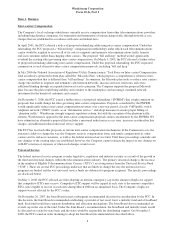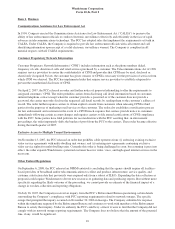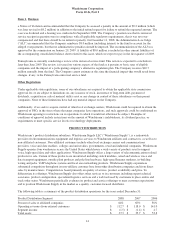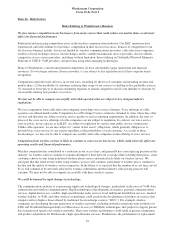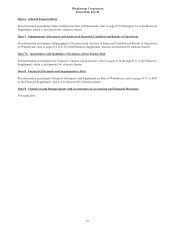Windstream 2008 Annual Report Download - page 66
Download and view the complete annual report
Please find page 66 of the 2008 Windstream annual report below. You can navigate through the pages in the report by either clicking on the pages listed below, or by using the keyword search tool below to find specific information within the annual report.
Windstream Corporation
Form 10-K, Part I
Item 1A. Risk Factors
efforts by carriers to mask traffic to avail their traffic of lower inter-carrier compensation rates. Absent any changes to
existing inter-carrier compensation regulations, the Company expects to experience a similar rate of reduction in inter-
carrier revenue in 2009 as experienced in 2008.
On November 5, 2008, the FCC issued a further notice of proposed rulemaking (“FNPRM”) that sought comment on
proposals that would change the rules governing inter-carrier compensation (see “Management’s Discussion and
Analysis of Financial Condition and Results of Operations, Financial Condition, Regulatory Matters – Wireline
Operations” in the Financial Supplement to this annual report on Form 10-K). Proposals considered by the FNPRM
would significantly reduce inter-carrier compensation revenues over a ten-year period, classify VoIP/PSTN traffic as
an “information service,” and adopt measures to ensure proper billing of “phantom traffic”. Adoption of the FCC’s
proposed plan could materially reduce the Company’s inter-carrier compensation revenue. We do not know whether
the FCC’s proposed plan, or a substantially similar plan, will be adopted.
In 2008, we received approximately 8% of our revenues from state and federal Universal Service Funds, and any
adverse regulatory developments with respect to these funds could adversely affect our profitability.
We receive state and federal USF revenues to support the high cost of providing affordable telecommunications
services in rural markets. Such support payments constituted approximately 8 percent of our revenues for the year
ended December 31, 2008. A portion of such fees are based on relative cost and access line counts, and we expect
receipt of such fees to decline as we continue to reduce costs and lose access lines. Pending regulatory proceedings
could, depending on the outcome, materially reduce our USF revenues.
The FNPRM issued by the FCC on inter-carrier compensation also sought comment on proposals that would cap high-
cost receipts based on the support each carrier is eligible to receive at December 2008 levels on an annualized basis. To
continue receiving this support under this proposal, high-cost recipients would have to certify that they would deploy
specified high-speed Internet services throughout their supported areas over a five-year period. Areas for which high-
cost recipients decline to make such certification would be subject to a reverse auction. Adoption of this proposal, or a
substantially similar proposal, could materially reduce the Company’s universal service revenues or increase its
operating costs.
We are required to make contributions to state and federal USF programs each year. Current state and federal
regulations allow us to recover these contributions by including a surcharge on our customers’ bills. If state and/or
federal regulations change, and we become ineligible to receive support, such support is reduced, or we become unable
to recover the amounts we contribute to the state and federal USF programs from our customers, our earnings and cash
flows from operations would be directly and adversely affected.
Windstream’s substantial debt could adversely affect our cash flow and impair our ability to raise additional capital
on favorable terms.
As of December 31, 2008, we had approximately $5.4 billion in long-term debt outstanding. We may also obtain
additional long-term debt to meet future financing needs or to fund potential acquisitions, subject to certain restrictions
under our existing indebtedness, which would increase our total debt. Our substantial amount of debt could have
negative consequences to our business. For example, it could:
• Increase our vulnerability to general adverse economic and industry conditions;
• Require us to dedicate a substantial portion of cash flows from operations to interest and principal payments on
outstanding debt, thereby limiting the availability of cash flow to fund future capital expenditures, working capital
and other general corporate requirements;
• Limit our flexibility in planning for, or reacting to, changes in our business and the telecommunications industry;
• Place us at a competitive disadvantage compared with competitors that have less debt; and
• Limit our ability to borrow additional funds, even when necessary to maintain adequate liquidity.
18


